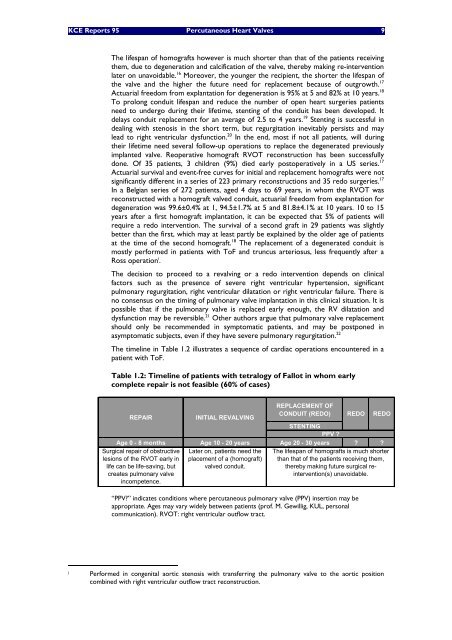Percutane hartklep implantatie bij congenitale en ... - KCE
Percutane hartklep implantatie bij congenitale en ... - KCE
Percutane hartklep implantatie bij congenitale en ... - KCE
Create successful ePaper yourself
Turn your PDF publications into a flip-book with our unique Google optimized e-Paper software.
<strong>KCE</strong> Reports 95 <strong>Percutane</strong>ous Heart Valves 9<br />
The lifespan of homografts however is much shorter than that of the pati<strong>en</strong>ts receiving<br />
them, due to deg<strong>en</strong>eration and calcification of the valve, thereby making re-interv<strong>en</strong>tion<br />
later on unavoidable. 16 Moreover, the younger the recipi<strong>en</strong>t, the shorter the lifespan of<br />
the valve and the higher the future need for replacem<strong>en</strong>t because of outgrowth. 17<br />
Actuarial freedom from explantation for deg<strong>en</strong>eration is 95% at 5 and 82% at 10 years. 18<br />
To prolong conduit lifespan and reduce the number of op<strong>en</strong> heart surgeries pati<strong>en</strong>ts<br />
need to undergo during their lifetime, st<strong>en</strong>ting of the conduit has be<strong>en</strong> developed. It<br />
delays conduit replacem<strong>en</strong>t for an average of 2.5 to 4 years. 19 St<strong>en</strong>ting is successful in<br />
dealing with st<strong>en</strong>osis in the short term, but regurgitation inevitably persists and may<br />
lead to right v<strong>en</strong>tricular dysfunction. 20 In the <strong>en</strong>d, most if not all pati<strong>en</strong>ts, will during<br />
their lifetime need several follow-up operations to replace the deg<strong>en</strong>erated previously<br />
implanted valve. Reoperative homograft RVOT reconstruction has be<strong>en</strong> successfully<br />
done. Of 35 pati<strong>en</strong>ts, 3 childr<strong>en</strong> (9%) died early postoperatively in a US series. 17<br />
Actuarial survival and ev<strong>en</strong>t-free curves for initial and replacem<strong>en</strong>t homografts were not<br />
significantly differ<strong>en</strong>t in a series of 223 primary reconstructions and 35 redo surgeries. 17<br />
In a Belgian series of 272 pati<strong>en</strong>ts, aged 4 days to 69 years, in whom the RVOT was<br />
reconstructed with a homograft valved conduit, actuarial freedom from explantation for<br />
deg<strong>en</strong>eration was 99.6±0.4% at 1, 94.5±1.7% at 5 and 81.8±4.1% at 10 years. 10 to 15<br />
years after a first homograft implantation, it can be expected that 5% of pati<strong>en</strong>ts will<br />
require a redo interv<strong>en</strong>tion. The survival of a second graft in 29 pati<strong>en</strong>ts was slightly<br />
better than the first, which may at least partly be explained by the older age of pati<strong>en</strong>ts<br />
at the time of the second homograft. 18 The replacem<strong>en</strong>t of a deg<strong>en</strong>erated conduit is<br />
mostly performed in pati<strong>en</strong>ts with ToF and truncus arteriosus, less frequ<strong>en</strong>tly after a<br />
Ross operation i .<br />
The decision to proceed to a revalving or a redo interv<strong>en</strong>tion dep<strong>en</strong>ds on clinical<br />
factors such as the pres<strong>en</strong>ce of severe right v<strong>en</strong>tricular hypert<strong>en</strong>sion, significant<br />
pulmonary regurgitation, right v<strong>en</strong>tricular dilatation or right v<strong>en</strong>tricular failure. There is<br />
no cons<strong>en</strong>sus on the timing of pulmonary valve implantation in this clinical situation. It is<br />
possible that if the pulmonary valve is replaced early <strong>en</strong>ough, the RV dilatation and<br />
dysfunction may be reversible. 21 Other authors argue that pulmonary valve replacem<strong>en</strong>t<br />
should only be recomm<strong>en</strong>ded in symptomatic pati<strong>en</strong>ts, and may be postponed in<br />
asymptomatic subjects, ev<strong>en</strong> if they have severe pulmonary regurgitation. 22<br />
The timeline in Table 1.2 illustrates a sequ<strong>en</strong>ce of cardiac operations <strong>en</strong>countered in a<br />
pati<strong>en</strong>t with ToF.<br />
Table 1.2: Timeline of pati<strong>en</strong>ts with tetralogy of Fallot in whom early<br />
complete repair is not feasible (60% of cases)<br />
REPAIR INITIAL REVALVING<br />
REPLACEMENT OF<br />
CONDUIT (REDO)<br />
STENTING<br />
PPV ?<br />
REDO REDO<br />
Age 0 - 8 months Age 10 - 20 years Age 20 - 30 years ? ?<br />
Surgical repair of obstructive Later on, pati<strong>en</strong>ts need the The lifespan of homografts is much shorter<br />
lesions of the RVOT early in placem<strong>en</strong>t of a (homograft) than that of the pati<strong>en</strong>ts receiving them,<br />
life can be life-saving, but valved conduit.<br />
thereby making future surgical re-<br />
creates pulmonary valve<br />
incompet<strong>en</strong>ce.<br />
interv<strong>en</strong>tion(s) unavoidable.<br />
“PPV?” indicates conditions where percutaneous pulmonary valve (PPV) insertion may be<br />
appropriate. Ages may vary widely betwe<strong>en</strong> pati<strong>en</strong>ts (prof. M. Gewillig, KUL, personal<br />
communication). RVOT: right v<strong>en</strong>tricular outflow tract.<br />
i Performed in cong<strong>en</strong>ital aortic st<strong>en</strong>osis with transferring the pulmonary valve to the aortic position<br />
combined with right v<strong>en</strong>tricular outflow tract reconstruction.

















